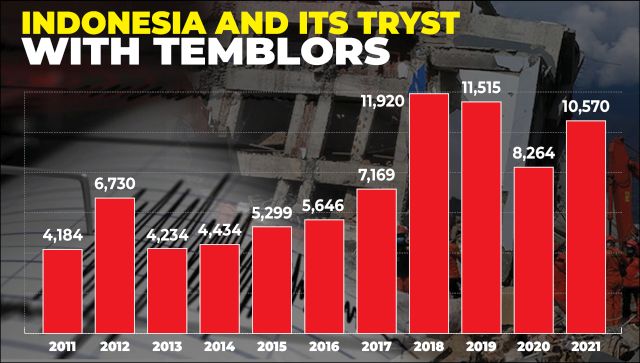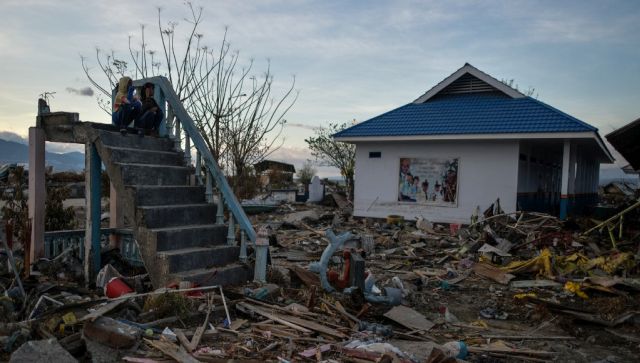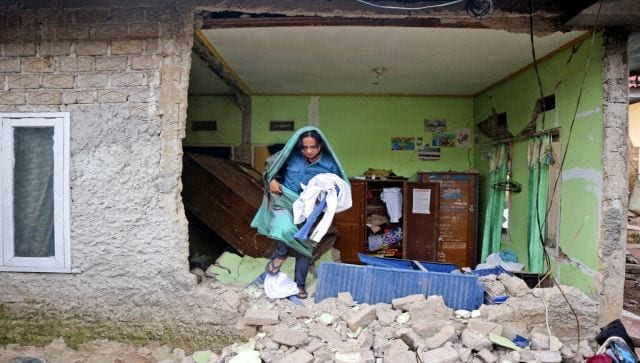Why a 5.6-magnitude earthquake claimed 162 lives and caused massive destruction in Indonesia’s Java
Why a 5.6-magnitude earthquake claimed 162 lives and caused massive destruction in Indonesia’s Java

An earthquake of 5.6 magnitude struck the main Indonesian island of Java on Monday. It might seem moderate on the Richter scale but the deaths and devastation caused are alarming. At least 162 people have succumbed to the quake and hundreds have been injured. The number is likely to mount.
The temblor struck Cianjur town in West Java, at a shallow depth of 10 km, according to US Geological Survey data.
Also read: From Nepal to China, the deadliest earthquakes that rocked the world
A catastrophe unfolds
Ridwan Kamil, the governor of West Java, told the media that a majority of those who died were children, as the disaster struck while school was on. The tremors caused several buildings to collapse.
More than 13,000 people have been displaced. According to Indonesia’s National Disaster Mitigation Agency (BNPB), at least 2000 homes were damaged.
Kamal told local media that 326 people have been injured in the quake, adding that most of them sustained fractures from being crushed in ruins, reports BBC. He warned some residents remained “trapped in isolated places” and said officials were “under the assumption that the number of injured and deaths will rise with time”.
According to some media reports, at least 700 sustained injuries in the calamity.

Rescue operations continue in Cianjur but many families in villages in the area have to be evacuated. “The ambulances keep on coming from the villages to the hospital,” Herman Suherman, the head of administration in Cianjur town told the news agency AFP.
Parts of the affected areas have no power and it could take up to three days for electricity to be fully restored. Kamil wrote on Twitter that mobile phone reception remained poor and was causing “a lot of problems” for officials.
Sitting on the ‘Ring of Fire’
It’s a story that has been heard from Indonesia for far too long. Each year, the country is hit by thousands of quakes, of course, some are mild. According to statistics, Indonesia was struck by a total of 10,570 earthquake activities in 2021, which is a significant rise compared to 2020 which logged 8,264 earthquakes.
Indonesia sits on the “Ring of Fire”, a band around the Pacific Ocean that sets off frequent tremors and volcanic activity. It is one of the most seismically active zones on Earth and stretches from Japan and Indonesia on one side of the Pacific to California and South America on the other, according to a report on CNN.
It is not exactly round but shaped like a horse. Spanning around 4,000 kilometres, this is where most of the worst earthquakes and 75 per cent of volcanoes occur within the Ring of Fire.
“Plate tectonics and the Ring of Fire are the main reasons why Indonesia has so many earthquakes and volcanic eruptions,” according to CNN meteorologist Allison Chinchar, adding that the earth below them is constantly changing and moving.

A 2017 earthquake map shows that the number of active faults across the Southeast Asian country have increased from 81 in 2010 to 295, reports The Statesman.
Earthquakes usually occur along faults – breaks in the rocky plates of the Earth’s crust. These faults accumulate strain over the years as two plates butt heads.
It’s why Indonesia sees so many damaging earthquakes. The most disastrous one in recent years is the 7.4-magnitude earthquake and subsequent tsunami in Central Sulawesi on 28 September 2018. It claimed 4340 lives and left 10,679 injured with 667 people missing. One of the deadliest catastrophes in the country, it caused widespread loss of life and property.
According to Indonesia’s Center of Volcanology and Geological Hazard Mitigatio, the deteriorating Palu-Koro fault amplified the jolt of the earthquake that hit Donggala regency in Central Sulawesi. A shift in the fault, a fracture in Earth’s crust, triggered the disaster, the report says.
Before the Central Sulawesi quake, eight big temblors were recorded in the country and five of them were above the magnitude of above 6 on the Richter scale.

Small quakes, big damage
In the earthquake-prone region, it is not always the magnitude that matters. Often smaller tremors lead to large-scale devastation, as we are seeing in Java.
The damage caused by a quake depends on the significant ground motion that it produces. According to a 2020 study published in Seismological Research Letters, small earthquakes can often be more damaging than large ones. It found that earthquakes that caused the strongest shaking were smaller in magnitude than expected and hence were significant contributors to seismic hazards.
“There is not one magnitude above which damage will occur. It depends on other variables such as the distance from the earthquake, what type of soil you are on, building construction, etc. That being said, damage does not usually occur until the earthquake magnitude reaches somewhere above 4 or 5,” according to the United States Geological Survey, a scientific agency of the American government.
There are more deaths and damage from a quake in places population density is high and buildings are poorly designed and constructed.

According to seismologist Dr John Ristau, “for a small magnitude earthquake to cause significant damage it would have to be very shallow and very close to human-built structures – depth will be very important as the amount of ground shaking drops off quickly with increasing depth”, reports the news website Stuff.
Monday’s quake in Java was at a shallow depth of 10 kilometres, according to data from US Geological Survey. The area where the quake struck is densely populated and prone to landslides with poorly built houses reduced to rubble in many areas, reports the BBC.
As the disaster continues to unfold, Indonesia picks up the pieces.
With inputs from agencies
Read all the Latest News, Trending News, Cricket News, Bollywood News,
India News and Entertainment News here. Follow us on Facebook, Twitter and Instagram.
What's Your Reaction?


























































